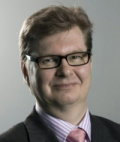The Past, The Present and The Future
Dr Juha Kaskinen, Director of the Finland Futures Research Center (FFRC), University of Turku is visiting the HSE Moscow in the framework of the ‘International Foresight Academy’ project developed by EU, the first organization to bind together foresight activities around the globe by supporting researcher mobility between leading Foresight Centers of Europe, North and South America, and Asia.
 |
| Juha Kaskinen |
— You have to travel between Russia and Finland back and forth a lot now to implement your ongoing joint projects with the HSE. What challenges does your cooperation with the HSE bring?
— On personal level, the main challenge is the language, unfortunately it would be easier if I could speak Russian. Or if colleagues here at the HSE could speak Finnish. But, I suppose that is too much to ask. But seriously, everyone speaks English here at the ISSEK and it works out pretty well, even if it would be better in some cases if Russian could be used.
On a general level, there are ‘normal’ challenges that are part of internationalization, like project based funding that can sometimes hinder continuous cooperation. The personnel in project based organizations are also always busy with projects and applying for new ones so it can be difficult to find time for activities like organising new contacts and networks, planning projects together, writing articles and so on. But realistically, you just have to try to find the necessary resources.
— What are the main issues and differences between different schools in futurology? Could you tell us about the differences between your work and that of blue-sky thinking experts? What’s happening here, in Moscow, on this issue?
— It seems to me that that in futures studies and foresight (we usually do not use the term futurology), it is more a question of approaches, not schools of thought as such. In corporate foresight, the tendency is to help a company or companies to map alternative futures and assist in their strategic planning and decision-making. In futures studies a researcher can be interested in, for example, epistemological or ontological questions or developing futures methods. Foresight is planning and decision-making orientated. Futures studies is a general discipline orientated towards questions about the future. Along with many colleagues, I would argue that both quantitative and qualitative methods must be applied to futures work, so that differentiation has started to blur.
Blue sky thinking and sometimes wild visions are an essential part of futures exercises, because we are not predicting the future, we are mapping different possible futures. Without visions it’s just impossible to create a desirable future.
— What is your teaching method? How do you inspire students?
— We use multiple teaching methods. Education and learning is nowadays more problem-orientated, and deals with real cases, as well as increasingly being carried out online. We use lot of group work and assignments. Lecturing is clearly decreasing and learning is increasingly taking place outside the class room. Here at FFRC, we are following and I hope in some cases creating this trend. For students we want to offer an interesting learning environment with challenging tasks, international groups to work with and hopefully also an inspiring social and cultural environment.
— What are you favorite places in Moscow? How do you spend your leisure time?
— Well, weekdays are taken up with work. I have been trying to see major historical sites of Moscow at the weekends, but I really can’t say what is my favorite yet. As a futurist, I know I have to understand history and I also know that there is plenty so see in Moscow for a history enthusiast.
Anna Chernyakhovskaya, specially for the HSE news service
